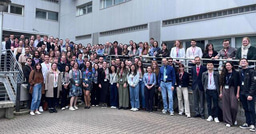Nurturing interdisciplinarity in the teaching of basic sciences by biomedical higher education establishments to develop a One Health culture in practice

The One Health concept has been highlighted as a holistic approach to health. It recognizes that humans, animals, and the environment are interconnected and promotes critical thinking, that is to say, thinking ‘out of the box’ that relies on the observation of links and overlaps among the human-animal-environment interfaces and their multilateral interactions. One Health, therefore, offers a better comprehension of issues around biological – or even psychological – needs of the different organisms, around disease and, overall, around health. This is not new. Human-animal models that apply in research and comparative medicine have been, to an extent, preliminary acknowledgements and implementation models of the One Health principles for many years now. Nevertheless, One Health nowadays has been recognised more consciously and valued especially in response to current global challenges, like prevention and treatment of emerging or zoonotic diseases, fighting against antimicrobial resistance, and food safety. The value of the One Health holistic concept that recognizes that the health of humans, animals and the environment is interlinked, has been acknowledged worldwide and promoted by all international organizations, which call for the implementation of interdisciplinary collaboration to competently tackle global health threats through a better coordination of activities around prevention, diagnosis, treatment, or food safety.
It is evident that within the One Health concept there is a need for multidisciplinary expertise, especially with regards to the overlapping areas of the human-animal-environment interfaces. There, the value of One Health intersectoral collaboration to efficiently tackle different health challenges is indisputable. To illustrate this, let’s take the example of early detection of a zoonotic outbreak in animals, which can allow the quick intervention and control of the disease in animals, preventing that way its spread to humans. Good channels to allow the flow of information between the different sectors are very important in such cases and have to be established and maintained during ‘peace’ times. So far, these channels of information have not been that well established. Why? Mainly because professionals have not been educated to interact and collaborate out of their own bubbles or sectors. Professionals have been trained in isolation and are disconnected from each other’s practice. This is what made health professions in Europe call on academia to promote a culture of One Health at university through the implementation of interdisciplinarity in education.
Agree on One Thing: the value of interdisciplinarity in education
A pan-European survey, conducted in 2018 among veterinary education establishments (VEE) in the European Union and the European Free Trade Area, highlighted a consensus of veterinary academics on the benefits of interdisciplinary education. Such a model of teaching provides a different educational experience and helps in creating a common understanding of One Health, by widening horizons, offering new opportunities, and promoting ‘thinking outside the box’. Therefore, this model better prepares students and professionals to cope with healthcare complex problems in their daily practice. Academic education has a crucial role in formulating the necessary attitudes and aptitudes of future biomedical professionals, and preparing them for their important role in ensuring One Health. The study presents the input from 41 European veterinary education establishments, 13 of which implement interdisciplinary education in their undergraduate curricula, while 27 do so in postgraduate training. Such opportunities – i.e., courses addressed to multisectoral audiences – are still at early stages within undergraduate curricula, but seems to be more easily implemented for postgraduate education.
Use the basic sciences to bring students together
The study elaborated on the liaisons of the veterinary education establishments with other education establishments and showed that basic sciences, e.g., physics, chemistry, biochemistry, biology, zoology, and botany, to name some, are fields that particularly offer opportunities for joint teaching both undergraduate (Table 1) and postgraduate (Table 2). It is worth reflecting on the fact that most of these disciplines are common subjects in the different sectoral curricula and, interestingly, they are taught at the first years of the studies. For example, physics, chemistry, and biochemistry, are core subjects in all medical, dental, and veterinary curricula in the first or second year of study. These subjects present excellent opportunities for the organization of joint teaching and for setting up the basis for intersectoral collaboration among different sectors, such as doctors, dentists, pharmacists, and biologists, for example. This is also confirmed by the results of our study, which show that most of the veterinary education establishments that provide interdisciplinary training opportunities to their undergraduate students do so in the first years of their studies, and for subjects considered as basic sciences. Further to this, basic sciences were also indicated as a prosperous area for developing joint teaching in the future by the establishments that participated in this study, but that do not yet integrate joint teaching in any of the basic sciences in their curricula.
|
TABLE 1: CASE PRESENTATION ON HOW VEEs ORGANIZE UNDERGRADUATE JOINT TRAINING WITH OTHER ACADEMIC ESTABLISHMENTS1 |
|||||||
|
Veterinary |
Medical |
Dental |
Pharmacology |
Basic sciences |
Environmental |
Social Sciences |
Other departments2 |
|
✔3 |
✔ |
||||||
|
✔ |
✔ |
✔ |
✔ |
✔ |
|||
|
✔ |
✔ |
✔ |
✔ |
✔ |
✔ |
||
|
✔ |
✔ |
✔ |
✔ |
✔ |
✔ |
||
|
✔ |
✔ |
||||||
|
✔ |
✔ |
✔ |
|||||
|
✔ |
✔ |
||||||
|
✔ |
✔ |
✔ |
|||||
|
✔4 |
|||||||
|
✔ |
✔ |
||||||
|
✔ |
✔ |
||||||
|
✔ |
✔ |
✔ |
✔ |
✔ |
|||
|
✔ |
✔ |
✔ |
|||||
|
13 |
6 |
0 |
4 |
7 |
3 |
5 |
3 |
|
1Each row represents a reply from one VEE 2Other agricultural or public health institutes 3Veterinary students can freely select courses organized by other faculties in the same university (elective courses) 4No details provided by the respondent |
|||||||
|
TABLE 2: CASE PRESENTATION ON HOW VEEs ORGANIZE POSTGRADUATE JOINT TRAINING WITH OTHER ACADEMIC ESTABLISHMENTS1 |
|||||||
|
Veterinary |
Medical |
Dental |
Pharmacology |
Basic sciences |
Environmental |
Social Sciences |
Other departments2 |
|
✔ |
✔ |
||||||
|
✔ |
✔ |
✔ |
|||||
|
✔ |
✔ |
||||||
|
✔ |
✔ |
✔ |
|||||
|
✔ |
✔ |
✔ |
✔ |
✔ |
✔ |
✔ |
|
|
✔ |
✔ |
✔ |
✔ |
✔ |
|||
|
✔ |
✔ |
||||||
|
✔ |
✔ |
✔ |
✔ |
✔ |
✔ |
||
|
✔ |
✔ |
✔ |
✔ |
✔ |
✔ |
||
|
✔ |
✔ |
✔ |
✔ |
||||
|
✔ |
✔ |
✔ |
|||||
|
✔ |
✔ |
||||||
|
✔ |
✔ |
✔ |
✔ |
✔ |
|||
|
✔ |
✔ |
✔ |
✔ |
||||
|
✔ |
✔ |
||||||
|
✔ |
✔ |
||||||
|
✔ |
✔ |
✔ |
|||||
|
✔ |
✔ |
✔ |
|||||
|
✔ |
✔ |
✔ |
✔ |
✔ |
|||
|
✔ |
✔ |
✔ |
✔ |
||||
|
✔ |
✔ |
✔ |
✔ |
✔ |
|||
|
✔ |
✔ |
✔ |
|||||
|
✔ |
✔ |
||||||
|
✔ |
✔ |
✔ |
✔ |
✔ |
|||
|
✔ |
✔ |
✔ |
|||||
|
✔ |
✔ |
||||||
|
✔ |
✔ |
✔ |
✔ |
✔ |
|||
|
27 |
21 |
3 |
10 |
13 |
10 |
2 |
12 |
|
1Each row represents a reply from one VEE |
|||||||
A valuable approach but challenging to implement
The basic sciences also offer great potentials for the development of joint research projects. Twenty-nine (29) out of the forty (40) veterinary education establishments that work on joint research projects with multidisciplinary teams do work on topics related to them. However, whilst the expected benefits of interdisciplinary education for the students, the professionals, and the society are undisputable, this model of education is yet difficult to implement at undergraduate level, and remains a rather underexplored educational tool. Although these results are limited to one discipline, namely veterinary medicine, they do provide some good insights, which are certainly food for thought. It is evident that changing the culture with which we approach the learning process at university level, to better facilitate a horizontal change in attitudes and to inspire more openness, needs particular attention. Important hurdles toward the implementation of interdisciplinary teaching and training at undergraduate level, which were highlighted in this study, are the different regulations that hinder innovation and openness of teaching methods in Europe. European laws, national legislation, academic and structural regulations, and implementation of different accreditation systems, are often obstacles against the development of any new learning process. Additionally, this model of teaching has its own challenges. Making teaching a course fit-for-purpose for multidisciplinary audiences requires of particular attention to the composition of the class to identify the appropriate level of knowledge for all classmates coming from different backgrounds. Additionally, it requires a proper design of the learning outcomes as well as of the assessment methods to address the level, and interests, of all involved students.
However, the benefits expected for the students from such an experience justify the need to pay attention and investigate this potential by the academic biomedical establishments. That is, however, not easy due to the important obstacles described above. In most European countries, even if academia is eager to explore such a model of higher education, this may not be easily applicable if it is not supported by a relevant policy reform of the regulations on professional qualifications for all professionals involved in biomedical sciences in the EU (Directive 2005/36/EU as amended by Directive 2013/55/EU). Such a policy reform should propose a framework to encompass One Health core competencies, which could be incorporated within the different curricula, irrespectively of the scientific area they focus on. Establishing a list of One Health Day-One competencies would help academic establishments, irrespectively of their discipline orientation, to identify the subjects in their curriculum where interdisciplinary training can be introduced as a solid teaching tool. One Health core competencies should integrate knowledge, skills, and attitudes, which will give the ability to each of the professionals to think holistically, design by searching input from other disciplines, and contribute with their skills as part of the whole team.
In conclusion, basic sciences are important fields that offer opportunities for the implementation of One Health interdisciplinary teaching and the promotion of One Health intersectoral collaboration. Moreover, considering that basic sciences are often part of the first years of the veterinary and other medical and biomedical curricula, it offers opportunities for establishing a One Health culture from early stages of the university study, that is to say creating the environment for setting up the basis for the interdisciplinary collaboration of the students throughout their whole study period and consequently of their professional intersectoral collaboration afterwards.
With those considerations, it is time to open a global dialogue to re-design academic education aiming at preparing health professionals to be able to implement a holistic approach in their practice, be innovative, and most efficient.
This article was written by Dr Despoina Iatridou, Doctor in Veterinary Medicine (DVM), PhD, Senior Policy Officer, Federation of Veterinarians of Europe, Belgium, and Professor Ana Bravo, Doctor in Veterinary Medicine (DVM), PhD, Full Professor, Department of Anatomy, Animal Production and Veterinary Clinical Sciences, Veterinary Faculty in Lugo, University of Santiago de Compostela, Spain.
Photo by Miguel Henriques on Unsplash





Join the FEBS Network today
Joining the FEBS Network’s molecular life sciences community enables you to access special content on the site, present your profile, 'follow' contributors, 'comment' on and 'like' content, post your own content, and set up a tailored email digest for updates.